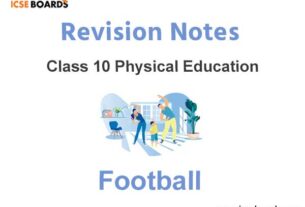Students should read the Inflation ICSE Economics Class 10 notes provided below. These revision notes have been prepared based on the latest ICSE Economics Books for Class 10 issued for the current academic year. Our teachers have designed thee notes for the students are able to understand all topics given in Economics in standard 10 and get good marks in exams
ICSE Class 10 Economics Inflation Revision Notes
Students can refer to the quick revision notes prepared for Chapter Economics Inflation in Class 10 ICSE. These notes will be really helpful for the students giving the Economics exam in ICSE Class 10. Our teachers have prepared these concept notes based on the latest ICSE syllabus and ICSE books issued for the current academic year. Please refer to Chapter wise notes for ICSE Class 10 Economics provided on our website.
Meaning of Inflation
Inflation is a sustained increase in the aggregate price levels. It refers to a state of rising prices and not a state of high prices.
Types of Inflation
The types of inflation observed in an economy depend on the rate of increase in the price levels and are follows:
- Creeping inflation is inflation where the price level increases at a very slow rate of 2–2.5% per annum.
- Walking inflation is inflation where the general price level of the economy increases at the rate of 5–6% per annum.
- Running inflation is inflation where the general price level increases faster and the rate of increase in price level is about 10% per annum. The inflation rate becomes a double digit figure.
- Hyperinflation is inflation where the general price level increases at the rate of 200% or more per month. Here, the price rise is ten or even a hundred-fold in a month.

Demand Pull Inflation
Demand pull inflation refers to the inflation generated by the pressure of excessive demand in an economy. If there is an excess of aggregate demand in the economy over aggregate supply, the general price level will tend to increase, which leads to inflation.
- The following are the three factors which cause demand-pull inflation:
o Population pressure: Heavy population pressure led to an increase in the demand for food items and other essential goods in the Indian market. This excess demand condition in the product market led to a price rise and it is termed demand-pull inflation.
o Growing government expenditure: A continuous increase in the government expenditure on infrastructural development and other developmental plans is essential. This generates more employment and income opportunities. It means additional purchasing power for the public to demand more goods and services.
o Growing supply of money: Increasing government expenditure and the credit policy of the government lead to an increase in flow of money within the economy. This in turn leads to an increase in demand for goods and services within the economy.
Cost-Push Inflation
An increase in the general price level of an economy with an increase in the average cost of production is called cost-push inflation. Cost-push factors are increase in the wage rate and increase in the prices of raw materials. Producers increase the prices of goods and services to maintain the profit rates after an increase in the cost of production.
- Factors responsible for the causes of cost-push inflation:
o Rise in wages: Rise in wages is considered a determinant of cost-push inflation. Because of trade unions, workers have organised strongly to get higher wages. This rise in wage cost may lead to the imposition of higher product price by producers. Hence, when the average prices of different consumption goods increase, workers would again demand for higher wages.
o Increase in the price of basic materials: Basic materials such as steel, chemicals and oil are used directly or indirectly in major industries. Thereby any increase in the prices of these basic materials affects the entire economy and the prices tend to increase.
o Higher taxes: Increase in taxes such as excise duties, sales tax and value added tax, where taxpayers can easily shift the burden of tax to the others, leads to an increase in the prices of different commodities.
Effects of Inflation
- Effects on Purchasing Power of Money
Purchasing power of money means the amount of goods and services which a unit of money can buy. During inflation, people will be able to consume lesser goods and services than before, i.e. real income declines.

- Effects on Production
When hyperinflation occurs in an economy because of uncertainty, there will be a negative effect in the production. It disrupts the price system and encourages hoarding. Hyperinflation reduces savings and capital accumulation which adversely affects production. - Effects on Distribution
o Fixed income groups: People who receive a fixed income are hit the hardest during periods of rising prices as their incomes remain fixed. The middle class, who by hardwork take care of their children’s education, find it difficult to survive in times of serious inflation.
o Borrowers: During inflation, when the prices rise and the real value of money goes down, the debtors pay back less in real terms than what they had borrowed, and thus to that extent they are gainers. On the other hand, the creditors get less in goods and services than what they had lent and hence lose in that context.

o Investors: When prices rise, the returns on equities go up on account of the rise in profits, while the bond and debenture holders gain nothing as their income remains fixed. By the same logic, holders will lose during depression, while the debenture and bond holders will stand to gain.
Control of Inflation
Monetary Measures
The three monetary policies of the Reserve Bank of India to control credit:
- Bank rate policy: The increase in the bank rate increases the cost of borrowing which reduces the borrowings of the commercial banks from the Central Bank. Consequently, the flow of money from the commercial banks to the public reduces. Therefore, inflation is controlled to the extent it is caused by bank credit.

- Cash reserve ratio (CRR): While controlling inflation, the Central Bank raises the CRR which reduces the lending capacity of commercial banks. Consequently, the flow of money from commercial banks to the public decreases. In the process, it halts the rise in prices to the extent it is caused by bank credits to the public.
- Open market operations: While controlling inflation, the Central Bank sells government securities to the public through banks. This results in the transfer of part of the bank deposits to the Central Bank account and reduces the credit creation capacity of commercial banks.
Fiscal Measures
Fiscal measures to control inflation include taxation, government expenditure and public borrowings. The choice of fiscal measures for controlling inflation depends on the causes of excess demand as follows:
- Government expenditure: When excess demand is caused by the government expenditure more than real output, the most effective measure is to cut down on public expenditure. A cut in public expenditure reduces not only the government’s demand for goods and services but also private consumption expenditure. Therefore, the excess demand decreases more than a given cut in public expenditure.
- Taxation: When excess demand is caused by private expenditure such as the expenditure by the households and firms, taxation of income is a more appropriate measure to control inflation. Taxation of income reduces disposable income. As consumer demand is a function of disposable income, consumer demand decreases because of taxation. Thus, a well-designed taxation policy reduces aggregate demand and thereby brings inflation under control.
- Public borrowing: Borrowings by the government to fund budget deficits uses idle money lying with banks and financial institutions for productive functions by investing it. When the government borrows money from the market, it reduces the purchasing power of the public.
Other Measures
- Price Control: When the government resorts to price control, a maximum retail price of goods and services is fixed. The primary objective is to prevent the price rise of scarce goods and to ration the use of the commodity. This measure is adopted to control hyperinflation.
- Wage Control: Wage control is used to combat inflation when wages tend to rise much faster than productivity. The government controls wage rise directly by imposing a ceiling on the wage incomes in both private and public sectors.
- Increase in Output: By increasing the level of output, the prices of essential consumer goods are maintained at a low level. Also, the government initiates a liberal import policy to overcome the shortfall of goods in the market.




